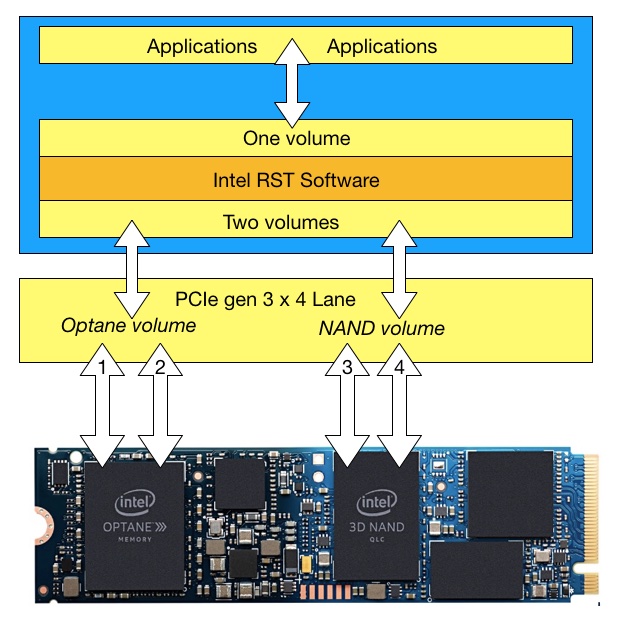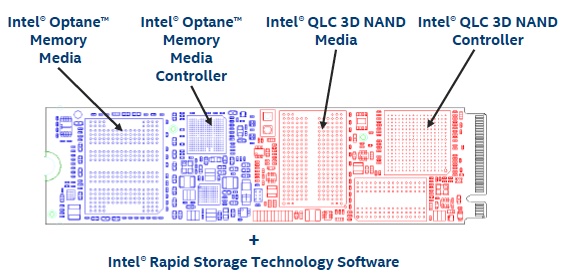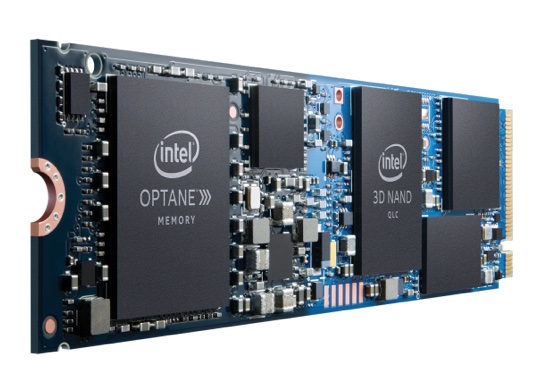Intel has made a dual non-volatile media drive that offers fast and slow access to a terabyte of data.
The Optane-NAND gumstick format H10 card drive presents itself as a single non-volatile storage volume, with frequent access files stored in the Optane tier and others in flash.
Target systems are space-constrained notebooks and gaming systems, which would get fast game loading. No pricing information is yet available.
Intel showed off the H10 at CES in January this year. It is an M.2 2280 or single-sided card, incorporating a small Optane 3D XPoint tier of storage and large tier of very much slower QLC (4bits/cell) flash storage. A host system, such as a thin and light notebook, hooks the card up via a PCIe gen 3 x 4-lane interface.

Two lanes go to the Optane storage and two to the NAND.

There are three capacity points:
- 256GB NAND and 16GB Optane – 272GB total
- 512GB NAND and 32GB Optane – 544GB total
- 1TB NAND and 32GB Optane – 1,056GB total
Full capacity
Intel’s RST (Rapid Storage Technology) software runs in the host notebook or desktop and presents the H10 capacity as a single volume with 272GB, 544GB or 1,056GB of capacity.
RST directs data accesses transparently via the Optane tier or the NAND tier to the accessing application. It can pin frequently accessed files in the Optane volume to ensure much faster access than other files in the QLC NAND.
System requirements for the H10 include an 8th generation Intel Core U series CPU and an Intel 300 series chipset (on-package PCH – Platform Controller Hub.)
The Optane volume’s latency is 18 μs reading and 19 μs writing. The QLC flash, built from 64-layer 3D NAND, has an SLC (1bit/cell) cache, which is faster than the QLC NAND. The SLC’s latency is around 90 μs while the QLC’s latency is around 660 μs – similar to Intel’s SSD 660p QLC NAND M.2 drive.
IOPS random read/write performance is up to 32,000/30,000 with a queue depth of 1, and 55,000/55,000 with a queue depth of 2. Intel says more than 90 per cent of application workloads operate in these queue depths. The sequential bandwidth is up to 2.4GB/sec reading and 1.8GB/sec writing. The H10 has a 5-warranty and an endurance of up to 300TB written.
The Optane area effectively acts as a caching tier for the H10 and can provide great fast-access performance while the QLC NAND offers high capacity in the M.2 format.
Opening large media files from the H10 can be up to 90 per cent faster than using a TLC (3bits/cell) SSD alone while the host system is multi-tasking. Games can be launched up to 60 per cent faster than off an SSD.
Initially, only Intel OEMs will sell the H10 with Best Buy OEMs Asus, Dell and HPE on the list and availability is slated for this quarter. Intel wants to recruit more retailers and big OEMs before opening sales channels to motherboard suppliers.








